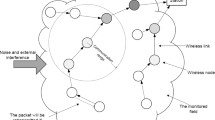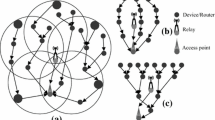Abstract
Wireless Sensor Networks (WSN) are usually a set of battery-supplied small devices. One of the main challenges in deploying WSN is to improve energy-efficiency and lifetime of the nodes while keeping communication reliability. Transmissions over the wireless channel may experience many impairments, like random noise and fading, increasing the bit error rate at reception, causing several retransmissions, and consuming extra energy from the node. In order to minimize the harmful effects of the radio channel, error control strategies using packet retransmission and error correcting codes are commonly utilized. In this work we investigate the trade-off between transmission and processing energy consumption in a sensor node employing convolutional codes. Through this study we can identify and select the appropriate complexity of the error control code to be used in each sensor node, in order to maximize the network lifetime.
Similar content being viewed by others
References
Akyildiz, I. F., Su, W., Sankarasubramaniam, Y., & Cayirci, E. (2002). Wireless sensor networks: a survey. Computer Networks Journal, 38(4), 393–422.
Polastre, J., Hill, J., & Culler, D. (2004). Versatile low power media access for wireless sensor networks. In Proceedings of ACM international conference on embedded networked sensor systems, Maryland (pp. 95–107).
Heinzelman, W. B., Chandrakasan, A., & Balakrishnan, H. (2000). Energy-efficient communication protocol for wireless microsensor networks. In Proceedings of the 33rd annual IEEE international conference on system sciences, Hawaii (pp. 2–10).
Karvonen, H., Shelby, Z., & Pomalaza-Raez, C. (2004). Coding for energy efficient wireless embedded networks. In Proceedings of the IEEE international workshop on wireless ad-hoc networks, Finland (pp. 300–304).
Desset, C., & Fort, A. (2003). Selection of channel coding for low-power wireless systems. In Proceedings of the 57th IEEE semiannual vehicular technology conference, South Korea (Vol. 3, pp. 1920–1924).
Kleinschmidt, J. H., Borelli, W. C., & Pellenz, M. E. (2008). An energy efficiency model for adaptive and custom error control schemes in Bluetooth sensor networks. AEU—International Journal of Electronics and Communications, doi:10.1016/j.aeue.2008.01.001 (in press).
Rappaport, T. S. (1996). Wireless communications: principles and practice. New York: Prentice Hall.
Proakis, J. G. (1995). Digital communications. New York: McGraw-Hill.
Hendrix, H. (2002). Viterbi decoding techniques for the TMS320C54x DSP generation. In Texas instruments application report SPRA071A.
Viterbi, A. (1967). Error bounds for convolutional codes and an asymptotically optimum decoding algorithm. IEEE Transactions on Information Theory, 13, 260–269.
Lin, S., & Costello, D. J. (1983). Error control coding: fundamentals and applications. New York: Prentice Hall.
Wicker, S. B. (1995). Error control systems for digital communication and storage. New York: Prentice Hall.
Chuang, A., Guillen, A. F., Rasmussen, L. K., & Collings, I. B. (2006). Optimal rate-diversity-delay tradeoff in ARQ block-fading channels. In Proceedings of the IEEE information theory workshop, Uruguay (pp. 507–511).
TinyOS 2.0 Documentation (2008). Available at http://www.tinyos.net.
McEliece, R. J., & Lin, W. (1996). The trellis complexity of convolutional codes. IEEE Transactions on Information Theory, 42(6), 1855–1864.
Atmel Corporation (2008). Available at http://www.atmel.com.
Crossbow Technology Inc. (2008). Available at http://www.xbow.com.
Chipcon Products from Texas Instruments (2008). Available at http://www.chipcon.com.
Author information
Authors and Affiliations
Corresponding author
Rights and permissions
About this article
Cite this article
Pellenz, M.E., Souza, R.D. & Fonseca, M.S.P. Error control coding in wireless sensor networks. Telecommun Syst 44, 61–68 (2010). https://doi.org/10.1007/s11235-009-9222-5
Published:
Issue Date:
DOI: https://doi.org/10.1007/s11235-009-9222-5




